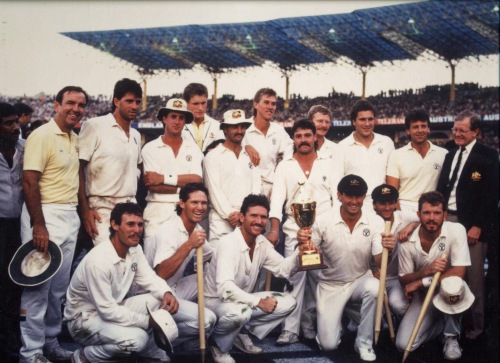Here’s part II of my World Cup Story.
The 1987 World Cup was the first staged outside England, so this could perhaps be regarded as the first time the tournament was a truly international event. It was staged by India and Pakistan under the slogan “Cricket for Peace”, chosen in reflection of the turbulent relationship that had often existed between the two nations since the 1947 partition. The title holders India, playing under home conditions, were favourites for victory closely followed by their co-hosts Pakistan – but again the event was won by the outsiders, this time Australia. The final was played out between England and Australia, anti-British feeling left from the colonial days still ran high in parts of India and the crowd really got behind Australia which Australian Captain Allan Border acknowledge had been a big help and encouragement. The victory was a real turning point for Australia, who had spent quite some time in the doldrums, and was the beginning of an extraordinary period of success for the national team.
WORLD CUP EFFECT 4 – The spirit of India gives Australia back it’s Mojo back – and it stayed in place for quite some time!
Dual hosts again for the 1992 World Cup, this time New Zealand and Australia. Staged in the homeland of Kerry Packer this was the first World Cup to feature coloured clothing, white balls and floodlights. Another notable feature of this tournament was that it marked South Africa’s return to the international cricketing fold after around 2 decades in the wilderness. Their entry was actually quite last minute and the organisers had to rewrite the fixtures to accommodate them!

Wonderful picture of the colourfully dressed teams with a fantastic backdrop (although you might notice the weather already looks pretty ominous!)
Australia had had a busy summer of regular international cricket and had not made any allowances in schedule for the fact they were hosting the World Cup, therefore the tournament was played very late in the season and many matches were effected by rain. These were the days before Duckworth/Lewis but for the tournament to progress results were needed so the ‘Rain Rule’ was introduced –
(a) The runs scored by the team batting second shall be compared with the runs scored by the team batting first from the equivalent number of highest scoring overs.
(b) If, due to a suspension of play, the number of overs in the innings of the team batting second has to be revised, their target score shall be the runs scored by the team batting first from the equivalent number of overs, plus one.
Confused? I know I am! An example of how (badly) it worked can be seen in one of the warm up games – India bowled out Victorian Country XI for just 156, India were then cruising nicely to their target at 129-3 after 31 overs when it began to rain hard…India were declared to have lost! The unfairness of the rain rule was to be felt by teams throughout the tournament.
The victors this time were Pakistan. Unlike India and Australia before them their victory did not herald a gold age in cricket for the nation but was to begin a period of marked decline.
WORLD CUP EFFECT 5 – lots of choice from this eventful World Cup but I’m going to go with the most obvious and visual – the bright lights and coloured clothing that was to change the look of international limited overs from that point on.
Next time: What happened next? The 1996 World Cup – I predict a riot.
(Bibliography – Wisden History of the Cricket World Cup edited by Tony Cozier, World Cup: Cricket’s Clash of the Titans by Peter Baxter)


